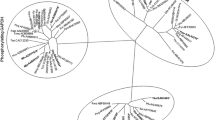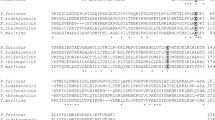Abstract
Glyceraldehyde 3-phosphate dehydrogenase (EC 1.2.1.12) from the extremely halophilic archaebacterium Haloarcula vallismortis has been purified in a four step procedure to electrophoretic homogeneity. The enzyme is a tetramer with a relative molecular mass of 160000. It is strictly NAD+-dependent and exhibits its highest activity in 2 mol/l KCl at 45°C. Amino acid analysis and isoelectric focusing indicate an excess of acidic amino acids. Two parts of the primary sequence are reported. These peptides have been compared with glyceraldehyde 3-phosphate dehydrogenases from other archaebacteria, eubacteria and eucaryotes. The peptides show a high grade of similarity to glyceraldehyde 3-phosphate dehydrogenase from eucaryotes.
Similar content being viewed by others
Abbreviations
- BCA:
-
bicinchoninic acid
- CTAB:
-
cetyltrimethyl ammonium bromide
- DTE:
-
dithioerythritol
- DTT:
-
dithiothreitol
- GAP:
-
glyccraldehyde 3-phosphate
- GAPDH:
-
glyceraldehyde 3-phosphate dehydrogenase
References
Banas T, Malarska A, Krotkiewska B, Marcinkowska A (1987) Glyceraldehyde 3-phosphate Dehydrogenase. Investigation of the regions responsible for self-assembly of subunits. Comp Biochem Biophys 87B: 391–401
Branlant G, Branlant C (1985) Nucleotide sequence of the E. coli GAP gene. Eur J Biochem 150: 61–66
Bülles J, Barzik H, Klosson RJ, Schickle HP, Gronau S (1990) Sensi Quant-Färbung: Eine hochempfindliche, quantifizierte und automatische Coomassi-Färbung von SDS-Elektrophorese-Gelen in der Proteinurie-Diagnostik mit Hilfe von Phast System. Pharmacia LKB GmbH, Freiburg, Germany (Sonderdruck A43)
Cazzulo JJ, Vidal MC (1972) Effect of monovalent cations on the malic enzyme from the extreme halophile Halobacterium cutirubrum. J Bacteriol 109: 437–439
Danson MJ (1989) Central metabolism of the archaebacteria: an overview. Can J Microbiol 35: 58–64
Eisenberg H (1990) Thermodynamics and the structure of biological macromolecules. Eur J Biochem 187: 7–22
Eisenman G, Krasne SJ (1973) The ion selectivity of carrier molecules, membranes and enzymes. In: Fox GF (eds) Biochemistry of cell walls and membranes MTP International Reviews Science Biochemistry, Series 2. Butterworths, London, pp 27–60
Eley MH, Burns PC, Kannapell CC, Campbell PS (1979) Cetyltrimethylammonium bromide polyacrylamide gel electrophoresis. Estimation of protein subunit molecular weights using cationic detergents. Anal Biochem 92: 411–419
Fabry S, Hensel R (1987) Purification and characterization of d-glyceraldehyde-3-phosphate dehydrogenase from the thermophilic archaebacterium Methanothermus fervidus. Eur J Biochem 165: 147–155
Fabry S, Hensel R (1988) Primary structure of glyceraldehyde 3-phosphate dehydrogenase deduced from the nucleotide sequence of the thermophile archaebacterium Methanothermus fervidus. Gene 64: 189–197
Fabry S, Lang J, Niermann T, Vingron M, Hensel R (1989) Nucleotide sequence of the glyceraldehyde 3-phosphate dehydrogenase gene from the mesophilic methanogenic Archaebacteria Methanobacterium bryantii and Methanobacterium formicicum. Eur J Biochem 179: 405–413
Fort P, Marty L, Peichaczyk M, ElSabrouty S, Dani C, Jeanteur P, Blanchard JM (1985) Various rat adult tissues express only one major mRNA species from the GAPDH multigenic family. Nucleic Acids Res 13: 1431–1442
Gochnauer M, Kushner DJ (1971) Potassium binding, growth and survival of an extremely halophilic bacterium. Can J Microbiol 17: 17–23
Gonzalez C, Gutierrez C, Ramirez C (1978) Halobacterium vallismortis sp. nov. An amylolytic and carbohydrate metabolizing extreme halophilic bacterium. Can J Microbiol 24: 710–715
Gropp F, Pieter WD, Sentenac A, Zillig W, Schnabel R, Thomm KM, Stetter KO (1986) Homologies of components of DNA-dependent RNA polymerases of Archaebacteria, Eucaryotes and Eubacteria. Syst Appl Microbiol 7: 95–101
Habeeb AFSA (1972) Reaction of protein sulfhydryl groups with Ellman's reagent. In: Hirs CHW, Timasheff SN (eds), Methods in enzymology, vol 25. Academic Press, New York London, pp 457–464
Hames BD (1981) An introduction to polyacrylamide gel electrophoresis. In: Hames BD, Rickwood D (eds) Gel electrophoresis of proteins: a practical approach. IRL Press Limited, London Washington DC, pp 6–14
Hensel R, Zwickl P, Fabry S, Lang J Palm P (1989) Sequence comparison of glyceraldehyde-3-phosphate dehydrogenase from the Three Urkingdoms: evolutionary implication. Can J Microbiol 35: 81–85
Hocking JD, Harris MI (1980) d-Glyceraldehyde 3-phosphate dehydrogenase: amino acid sequence of enzyme from the extremely thermophile Thermus aquaticus. Eur J Biochem 108: 567–579
Holland JP, Holland MJ (1979) The primary structure of a glyceraldehyde 3-phosphate dehydrogenase gene from Saccharomyces cerevisiae. J Biol Chem 254: 9839–9845
Huang XY, Barrios LAM, Vonkhorporn P, Honda S, Albertson DG, Hecht RM (1989) Genomic organization of the glyceraldehyde 3-phosphate dehydrogenase gene family of Caenorhabditis elegans. J Mol Biol 206: 411–424
Krahl-Mateblowski U (1988) Isolierung und Charakterisierung der Glyceraldehyd 3-Phosphat Dehydrogenase aus Halobacterium salinarium. Dissertation, Ruhr-Universität Bochum, Bochum, Germany
Krishnan G, Altekar W (1990) Characterization of a halophilic glyceraldehyde 3-phosphate dehydrogenase from the archaebacterium Haloarcula vallismortis. J Gen Appl Microbiol 36: 19–32
Kushner DJ (1978) Life in high salt and solute concentrations: halophilic bacteria. In: Kushner DJ (ed) Microbial life in extreme environments. Academic Press, London pp 318–357
Lanyi JK (1974) Salt-dependent properties of proteins from extreme halophile bacteria. Bacteriol Rev 38: 272–290
Lanyi JK (1980) Physical chemistry and evolution of salt tolerance in halobacteria. Origins Life 10: 161–167
Martinez P, Martin WF, Cerff R (1989) Structure, evolution and anaerobic regulation of a nuclear gene encoding cytosolic glyceraldehyde 3-phosphate dehydrogenase from maize. J Mol Biol 208: 551–565
Meyer HE, Meyer GF, Dirks H, Heilmeyer LMGJr, (1990) Localization of phosphoresine residues in the α-subunit of rabbit skeletal muscle phosphorylase kinase. Eur J Biochem 188: 367–376
Monstadt G, Holldorf AW (1990) Arginine deiminase from Halobacterium salinarium: purification and properties. Biochem J 273: 739–745
Quigley F, Martin WF, Cerff R (1988) Intron conservation across the procaryote-eucaryote boundary: structure of the nuclear gene for chloroplast glyceraldehyde 3-phosphate dehydrogenase from maize. Proc Natl Acad Sci USA 85: 2672–2676
Rawal N, Kelkar SM, Altekar W (1988) Alternative routes of carbohydrate metabolism in halophilic archaebacteria. Indian J Biochem Biophys 25: 647–686
Schultes V, Deutzmann R, Jaenicke R (1990) Complete amino acid sequence of glyceraldehyde 3-phosphat dehydrogenase from the hyperthermophilic eubacterium Thermotoga maritima. Eur J Biochem 195: 25–31
Sehgal SN, Gibbons NE (1960) Effect of some metal ions on the growth of Halobacterium cutirubrum. Can J Microbiol 6: 165–169
Shih M, Lazar G, Goodman HM (1986) Evidence in favor of the symbiotic origin of chloroplasts: primary structure and evolution of tobacco glyceraldehyde 3-phosphate dehydrogenases. Cell 47: 73–80
Smith PK, Krohen RJ, Hermansen GT, Mallia AK, Gartner FH, Provenzano MD, Fujimoto K, Goeke NM, Olsen BJ, Klenk DC (1985) Measurement of protein using bicinchoninic acid. Anal Biochem 150: 76–85
Warburg O, Christian W (1939) Isolierung und Kristallisation des Proteins des oxidierenden Gärungsfermentes. Biochem Z 303: 41–68
Woese CR, Fox GE (1977) Phylogenetic structure of the procaryotic domain: the primary Kingdoms. Proc Natl Acad Sci USA 74: 5088–5090
Woese CR, Kandler O, Wheelis ML (1990) Towards a natural system of organisms: proposal for the domains Archaea, Bacteria and Eucarya. Proc Natl Acad Sci USA 87: 4576–4579
Zwickl P, Fabry S, Bogedain C, Haas A, Hensel R (1990) Glyceraldehyde 3-phosphate dehydrogenase from the hyperthermophilic archaebacterium Pyrococcus woesei. Characterization of the enzyme, cloning and sequencing of the gene and expression in Escherichia coli. J Bacteriol 172: 4329–4338
Author information
Authors and Affiliations
Rights and permissions
About this article
Cite this article
Prüß, B., Meyer, H.E. & Holldorf, A.W. Characterization of the glyceraldehyde 3-phosphate dehydrogenase from the extremely halophilic archaebacterium Haloarcula vallismortis . Arch. Microbiol. 160, 5–11 (1993). https://doi.org/10.1007/BF00258139
Received:
Accepted:
Issue Date:
DOI: https://doi.org/10.1007/BF00258139




